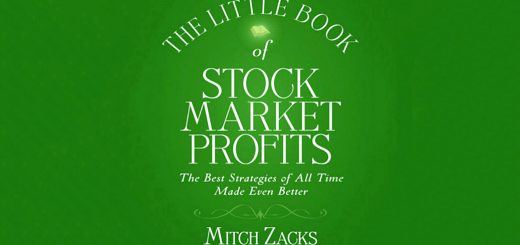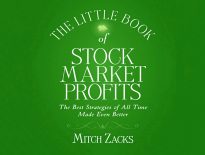Stock Market Profits 4 – surprises, seasons & multi-factor scores

Today’s post is our fourth visit to The Little Book of Stock Market Profits by Mitch Zack. Today we’re going to look at earnings surprises, seasonal effects and multi-factor strategies.
Earnings Surprises
An earnings surprise occurs when the quarterly (in the US) earnings number for a company is significantly higher or lower than analyst consensus (average) figure.
- Mitch’s firm came up with concept of consensus earnings in the 1980s., as a proxy for market expectations.
Companies that report earnings better than consensus earnings estimates tend to outperform the market over the next several months. The reverse is true for companies that report earnings weaker than consensus.
This is known as post-earnings announcement drift.
- It can last anything from three to 12 months.
The anomaly is more consistent over time than the other strategies in the book.
- It is stronger with stocks that have low institutional ownership.
- And higher media coverage of earnings surprises tends to increase drift.
Mitch suggests ranking stocks by the size of their earnings surprise:
Stocks that have reported large positive earnings surprises should be purchased, while those that have reported large negative surprises should be avoided or shorted.
Market-neutral portfolios based on earnings surprises generate gross returns from 4% to 7% per quarter.
Roughly only 13% to 20% percent of the post-earnings announcement drift occurs in the first five days following the earnings surprise.
Mitch notes that there are several ways to calculate an earnings surprise, and you need to be sure that you are comparing apples with apples.
- We’ll be using the Stockopedia definition, so this problem should not arise.
Many investors believe that earnings expectations – particularly in the US – are managed so that they are relatively easy to beat.
- While this seems to be the case for certain high-profile companies (eg. Apple), in aggregate analysts are too optimistic.
Most companies don’t beat estimates, which is why the ones that do perform so well.
Mitch has three possible explanations for post-earnings drift.
One is that the effect is correlated with macro factors.
- It appears to work best after periods of inflation.
The assumption here is that investors don’t notice the inflation (frog in a pan) until the jump in earnings makes them realise.
- Other correlated macro factors are a fall in production, consumption and labor income.
Mitch doesn’t buy this explanation, and prefers a behavioural one.
- The simplest he can find is that qualitative asset managers are swamped by information during the earnings season, and it takes them some time to process everything.
A third option is that a strategy involving quarterly reporting involves a lot of turnover and so it is not widely implemented by institutions due to transaction costs.
Institutions tend to implement a post-earnings announcement drift strategy less aggressively among companies that have higher transaction costs.
Who in aggregate is selling stocks into a positive earnings surprise? The answer, unfortunately, seems to be individuals.
Seasonal effects
Mitch accepts that there are seasonal effects in the stock market, but warns about data mining.
- He gives the example of stocks with the letter M outperforming the market during the period that Microsoft was the best performing stock of all.
- The finding is true, but it means nothing.
There has to be one day of the week and one day of the month and one month of the year that performs the best.
- And another that performs the worst.
The other problem is a lack of data.
- For example, working out which political party is best for the stock market is hampered by the small number of presidents / governments over a significant period of time.
- Eleven (now 13) presidents since the war is not enough to draw any conclusions.
Mitch recommends making only slight peaks based on seasonal data.
- For example, trade with the institutions in the afternoon rather than with the individuals in the morning.
He also recommends using the patterns in futures trading, where costs are low and leverage is high.
- I imagine they would work quite well as hedge-style overlays on a stock portfolio implemented through spread bets.
But overall he remains skeptical, and thinks that remaining invested will produce better long-term returns than timing your way in and out of the market based on seasonal patterns.
Here are the patterns that Mitch observes:
- January Effect: Small-cap stocks outperform.
- Since 1995, the effect seems to have move forward to December.
- January Barometer: as goes January, so goes the year (particularly if January is up).
- This is another effect where the recent data is weaker.
- May/October Effect:
- In the UK this is the Sell in May approach.
- In the US they also have a Rosh Hashanah to Yom Kippur effect.
- And a Congress effect (lower returns and higher volatility when Congress is sitting).
- Days-of-the-Week: Friday is best and Monday worst.
- Holiday Effect: the day before a holiday is usually good.
- Presidential Terms: returns are higher in the last two years of a President’s term.
- Returns are also higher when the President is Republican.
- But small-caps do better under Democrats (and worse under Republicans).
- Turn-of-the-Month: outperformance from both small and large caps on the first trading day of the month.
- Overnight Returns: are much higher than intraday returns (which are almost zero).
- Weather: sunshine produces higher returns.
Mitch thinks that Turn-Of_The-Month effect is the strongest.
- The May / October effect is the second strongest.
- He “recommends” (not quite) going long on cyclicals in the winter and defensives in the summer.
Using these calendar anomalies is not advised. Over the years I have yet to find a successful investor who obtained his or her returns through market timing.
Multi-Factor Strategies
The idea here is that the combination of two or more factors will generate returns that are greater than by using any one of the factors.
Mitch uses value and momentum (VM) as an example.
Note that the improvement will only occur if both factors are real.
- If one has been produced by data mining, there will be a dilution effect instead.
Another problem comes from selecting (say) a pair of factors that have each done well recently, rather than over the long term.
A third problem is the sheer number of factors to choose from.
- It’s too easy to switch from under-performing combinations to a new hot pair.
Mitch is particularly interested in multi-factor models where the individual factors themselves don’t generate excess returns, but the combination appears to be greater than the sum of its parts – there is a Gestalt effect.
The two he is interested in are the Piotroski F score for value stocks (9 elements) and the Mohanram G score for growth stocks (8 elements).
The idea is that the F or G scores accomplish what a good stock analyst does – identify stocks that can generate excess returns over the market.
The obvious concern is data mining – how many other factors were rejected before the measures were finalised.
- And how many non-functional rival measures were never published?
Mitch uses the Dogs of the Dow strategy as anm example of data mining.
This strategy focuses on buying the 10 stocks in the Dow Jones industrial average that have the highest dividend yield (expected dividend divided by price).
The idea is that the dividend yield is a good proxy for value, and the historical analysis looked great.
Unfortunately, if you performed the historical test not at year-end but instead at mid-year, the returns were not nearly as strong.
The test for data mining is to use out-of-sample data – a time period or dataset that the strategy was not created on.
- You can use international data, or a time period subsequent to the creation of the model.
F Score
The F Score was developed by Chicago accounting professor Joseph Piotroski.
- It looks for stocks with improving fundamentals, which are more likely to recover from a currently depressed state.
There are nine factors which look at three key measures – profitability, leverage, and operating efficiency.
The F score meaures:
- return on assets,
- the change in return on assets,
- cash flow from operations,
- an earnings accrual measure,
- change in gross margins,
- change in a firm’s asset turnover ratio,
- change in debt ratios,
- change in the ratio of current assets to current liabilities, and
- whether a firm issued common equity in the previous year.
All changes are measured over the past year, and you score one point for each improvement (or positive value in the case of RoA_.
- A score of 8 or 9 is excellent (though I am happy to buy stocks at 6 and 7, too).
Mitch would long 8s and 9s, and short 0s and 1s.
- This hedged portfolio generates annual returns of more than 10%, mostly on the long side.
Mitch points out that the F-score hasn’t worked so well since it was discovered, though he likes the underlying rationale.
- He would use it as an additional selection criteria in value screens.
Note that it doesn’t work well for growth stocks.
G Score
The G score for growth stocks was developed by Partha Mohanram of Columbia University.
Growth investors tend to mistakenly assume that past sales or earnings growth will continue into the future.
The G score tries to identify and avoid companies that, due to a lack of stability in historical sales and earnings growth, may be due to experience a growth hiccup.
The G score looks for profitable companies with historically stable earnings growth, and short-term money losing activities (such as R&D spend).
The G-score compares eight factors to their industry median values.
- Unlike the F score, the G-score is about avoiding losers as opposed to selecting winners.
The G-score looks at:
- return on assets,
- cash flow from operations vs net income,
- cash flow from operations scaled by assets,
- the variance of the return on assets over the past five years,
- the variance of sales over the past five years, as well as
- R&D expenditures,
- capital expenditures, and
- advertising expenses
A company scores 1 point for each item that is above its indutry median.
Mitch says that long G-8 stocks and short G-0 stocks produces excess returns, but mostly from the short side.
- As with the F score, since its publication in 2005, the G Score has had less predictive strength.
Conclusions
Once again, this has been an easy tour of three more chapters – the final three – of the book.
- I knew about earnings drift, and I will be ignoring seasonal factors.
- I knew about the F-score but not the G-score.
I’ll be back in a couple of weeks with a summary of the lessons from the book.
- And then we’ll move onto trying to build some stock screens from them.
Until next time.














